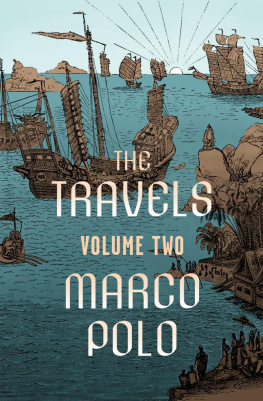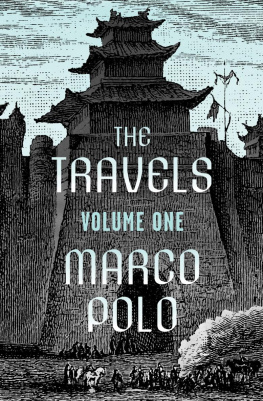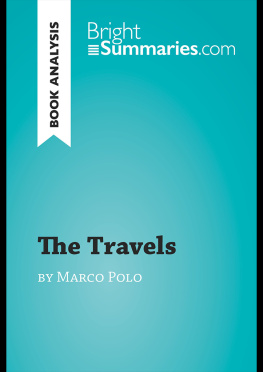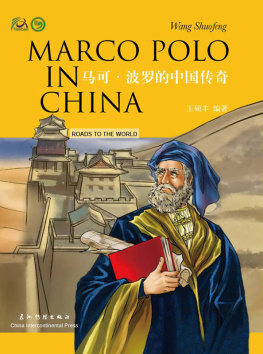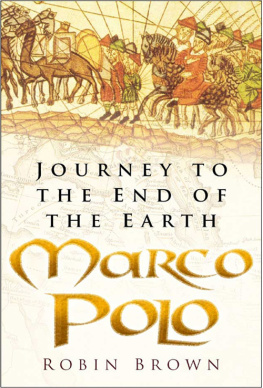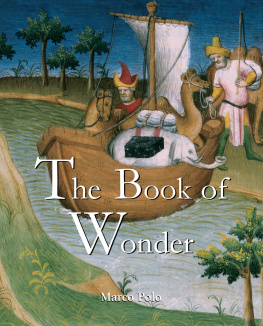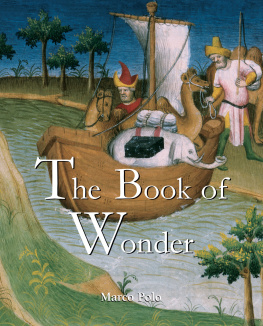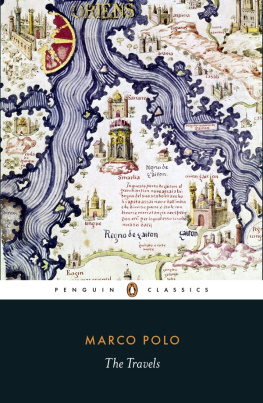Introduction

THE book most familiar to English readers as The Travels of Marco Polo was called in the prologue that introduced it to the reading public at the end of the thirteenth century a Description of the World (Divisament dou Monde). It was in fact a description of a surprisingly large part of the world from the Polar Sea to Java, from Zanzibar to Japan and a surprisingly large part of it from first-hand observation. The claim put forward in the prologue, that its author had travelled more extensively than any man since the Creation, is a plain statement of fact, so far at least as it relates to anyone who has left a record of his travels. Even among the Arab globe-trotters he had no serious competitor till Ibn Batuta, two generations later. And to western Christendom the world he revealed was almost wholly unknown. Some stretches of the trail he blazed were trodden by no other European foot for over 600 years not, perhaps, till the opening of the Burma Road during the last war. And the task of putting it on the map, in the most literal sense, is not yet complete.
The book can be enjoyed by the modern reader, as it was by the contemporary, for its own sake, as a vivid description of a fantastic world so remote from his own experience that it scarcely matters whether he thinks of it as fact or fiction. The inquirer who wishes to explore this world more thoroughly, in order to read the book with a just appraisal of its place in the development of human intercourse and knowledge, will find himself embarked on a journey potentially as long and varied as Polos own. The outline sketch that follows is intended merely to set him on the right track.
Ever since the days of Alexander the Great, the Western world had had some knowledge of India; and the trade-route across the Indian Ocean was still open to adventurous Europeans in the sixth century A.D., when Cosmas the India voyager visited the Malabar Coast. But north and east of India lay parts unknown. Though great quantities of Chinese silk were carried year by year along the caravan trails of Central Asia for sale in the Roman Empire, no one in the West seems to have had any notion of the country from which it had come or those through which it had passed. The Seres who produced it were no more than a name. It is not till the seventh century that we find a European writer, Theophylactus Simocatta, who betrays even a remote knowledge of the Chinese Empire a knowledge derived from envoys who had come to the imperial court at Constantinople from a Turkish kingdom in Central Asia. And in this same century sea-routes and land-routes alike were barred by the meteoric rise of Islam, which interposed its iron curtain between West and East
Trade relations, indeed, were soon resumed and became brisker than ever. Christian merchants from Constantinople and the rising mercantile republics of Italy Pisa, Genoa, Venice cheerfully imperilled their souls by trading with the infidel. But they seldom penetrated beyond the sea-ports of the Mediterranean and the Black Sea. Further stages were in the hands of Moslem middlemen, who exploited and explored their commercial empire with tireless energy. Before the Chinese closed their ports to foreigners in 878, the sea-route to China had become quite familiar to Arab merchants. Massudi of Baghdad in the tenth century records the experiences of a roving life that had led him as far afield as Africa, the Aral Sea, and Ceylon, perhaps even as far as southern China. To Jews the iron curtain was by no means impenetrable. Rabbi Benjamin of Tudela in Navarre, who visited Baghdad in the twelfth century, was well informed about the fortunes of his fellow Jews as far east as China. But in all this activity, and the new knowledge that sprang from it, western Christendom had no share. Western scholars were beginning to study Arabic and Jewish writings on metaphysics and medicine, alchemy and astronomy, but not, it would seem, on practical geography. The Christian communities who lived under Moslem rule, or farther east in India and China, were heretics in the eyes of Constantinople and Rome and were disqualified for the role of intermediaries by barriers of language and culture as well as creed. East and West were two different worlds.
After 1100, when the First Crusade established a fringe of Norman or Frankish principalities, owing allegiance to the Roman church, along the coast of Syria and Palestine, contact between the two worlds became closer but not, generally speaking, more cordial. In face of this threat from the West, the Moslem rulers dropped their mutual quarrels. The forces of Islam, united under Saladin, drove the invaders into the sea, leaving them little more than the precarious foothold of Acre (regained for Christendom in the Third Crusade by Richard Coeur de Lion and retained till 1291). Then in the Fourth Crusade of 1205 Latin Christianity scored a further triumph, this time at the expense of its Greek rival, by the seizure of Constantinople. A Frankish emperor, Baldwin of Flanders, was set on the throne of Constantine, while three-eighths of the imperial city were handed over to be governed by the Venetians, who had played a major part in its capture. Papal statesmen aspired to rule over a reunited Christendom. Venetian merchants, already holding the nearer East in fee, were on the alert for any chance to extend their commercial empire into a wider sphere. And at this moment of expectancy the iron curtain of Islam was split asunder by a thunderbolt from a quarter almost as unknown to Islam itself as it was to Christendom.
To the civilized peoples of the world, from Europe to China, the nomads of the Central Asian steppes with their deadly archery, their perfect mastery of horse-power, their incredible hardihood and mobility, had been a perpetually recurring menace. The Islamic world in particular had endured successive inroads of marauders from Turkestan, who had established themselves as military despots over Persians and Arabs. These Turkish conquerors had been tamed and enrolled among the followers of the Prophet, whose spiritual empire they helped to spread ever farther into the heart of the continent But in those illimitable grasslands there were still bands of wandering herdsmen whom his message had not reached; and chief among these were the
The passage of a Mongol army left in its immediate wake a clearly marked trail of devastation and death (pp. brood as Tartars. In 1260 Pope Alexander IV addressed to all the princes of Christendom an appeal for unity in face of the common danger the bull Clamat in auribus:
There rings in the ears of all, and rouses to vigilant alertness those who are not befuddled by mental torpor, a terrible trumpet of dire forewarning which, corroborated by the evidence of events, proclaims with so unmistakable a sound the wars of universal destruction wherewith the scourge of Heavens wrath in the hands of the inhuman Tartars, erupting as it were from the secret confines of Hell, oppresses and crushes the earth that it is no longer the task of Christian people to prick up their ears so as to receive surer tidings of these things, as though they were still in doubt, but their need is rather for admonition to take provident action against a peril impending and palpably approaching.
Yet in Western eyes there were compensations. The Christian victims of the Mongol tornado were mainly Russians, adherents of the schismatic Greek church; and Christendom as a whole had suffered far less than its hereditary foe Islam. When the Moslems in desperation appealed to the Christian princes for aid, the normal reaction was that expressed by the bishop of Winchester: Let dog bite dog. But there were some who even saw in the unspeakable Tartar a promising ally. Being ignorant of civilization, he must be the more susceptible to its allurements. Having only the vaguest religious beliefs, with no organized priesthood to sustain them, he must surely be ripe for conversion. And he had certainly created a potential free-trade area of unlimited extent. To the diplomat, the missionary, and the merchant, here was a virgin field. And its opportunities were not wholly neglected. Two courageous and keen-eyed Franciscan friars, Giovanni di Piano Carpini, sent in 1245 by Pope Innocent IV, and Guillaume de Roubrouck, sent in 1253 by Louis IX of France, made the interminable journey to Karakorum with offers of baptism and alliance and returned with interesting but not very encouraging reports.Maffeo Polo, set sail from Constantinople for the Crimean port of Sudak in search of a more profitable market for their wares deaf to the terrible trumpet of dire forewarning and quite unaware that they had stepped into the Prologue to one of the worlds classics.


